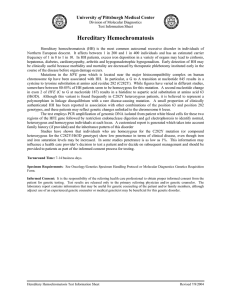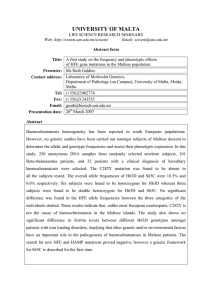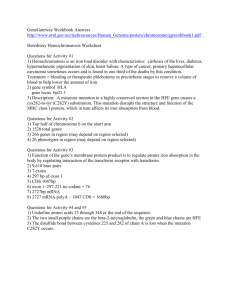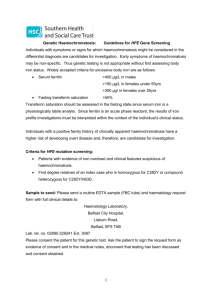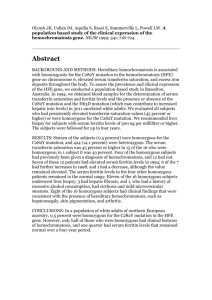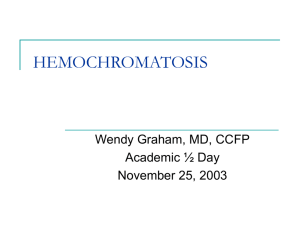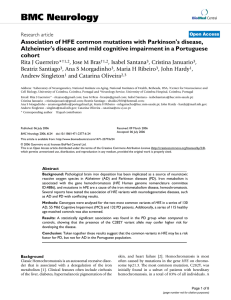Document 14233784
advertisement
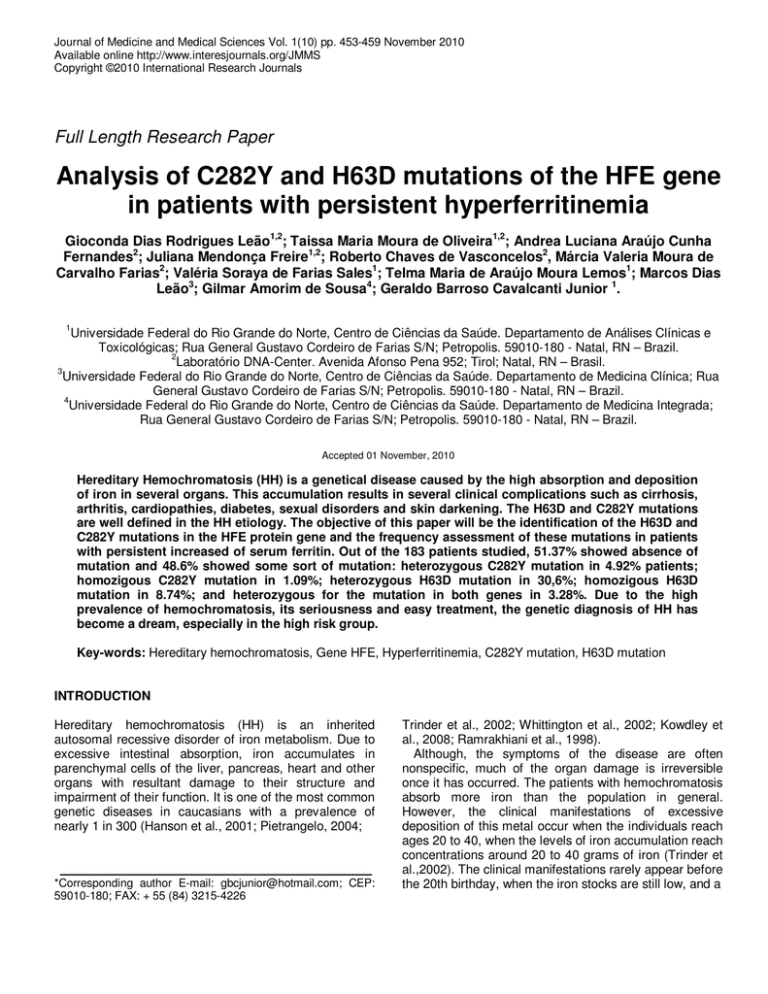
Journal of Medicine and Medical Sciences Vol. 1(10) pp. 453-459 November 2010 Available online http://www.interesjournals.org/JMMS Copyright ©2010 International Research Journals Full Length Research Paper Analysis of C282Y and H63D mutations of the HFE gene in patients with persistent hyperferritinemia Gioconda Dias Rodrigues Leão1,2; Taissa Maria Moura de Oliveira1,2; Andrea Luciana Araújo Cunha Fernandes2; Juliana Mendonça Freire1,2; Roberto Chaves de Vasconcelos2, Márcia Valeria Moura de Carvalho Farias2; Valéria Soraya de Farias Sales1; Telma Maria de Araújo Moura Lemos1; Marcos Dias Leão3; Gilmar Amorim de Sousa4; Geraldo Barroso Cavalcanti Junior 1. 1 Universidade Federal do Rio Grande do Norte, Centro de Ciências da Saúde. Departamento de Análises Clínicas e Toxicológicas; Rua General Gustavo Cordeiro de Farias S/N; Petropolis. 59010-180 - Natal, RN – Brazil. 2 Laboratório DNA-Center. Avenida Afonso Pena 952; Tirol; Natal, RN – Brasil. 3 Universidade Federal do Rio Grande do Norte, Centro de Ciências da Saúde. Departamento de Medicina Clínica; Rua General Gustavo Cordeiro de Farias S/N; Petropolis. 59010-180 - Natal, RN – Brazil. 4 Universidade Federal do Rio Grande do Norte, Centro de Ciências da Saúde. Departamento de Medicina Integrada; Rua General Gustavo Cordeiro de Farias S/N; Petropolis. 59010-180 - Natal, RN – Brazil. Accepted 01 November, 2010 Hereditary Hemochromatosis (HH) is a genetical disease caused by the high absorption and deposition of iron in several organs. This accumulation results in several clinical complications such as cirrhosis, arthritis, cardiopathies, diabetes, sexual disorders and skin darkening. The H63D and C282Y mutations are well defined in the HH etiology. The objective of this paper will be the identification of the H63D and C282Y mutations in the HFE protein gene and the frequency assessment of these mutations in patients with persistent increased of serum ferritin. Out of the 183 patients studied, 51.37% showed absence of mutation and 48.6% showed some sort of mutation: heterozygous C282Y mutation in 4.92% patients; homozigous C282Y mutation in 1.09%; heterozygous H63D mutation in 30,6%; homozigous H63D mutation in 8.74%; and heterozygous for the mutation in both genes in 3.28%. Due to the high prevalence of hemochromatosis, its seriousness and easy treatment, the genetic diagnosis of HH has become a dream, especially in the high risk group. Key-words: Hereditary hemochromatosis, Gene HFE, Hyperferritinemia, C282Y mutation, H63D mutation INTRODUCTION Hereditary hemochromatosis (HH) is an inherited autosomal recessive disorder of iron metabolism. Due to excessive intestinal absorption, iron accumulates in parenchymal cells of the liver, pancreas, heart and other organs with resultant damage to their structure and impairment of their function. It is one of the most common genetic diseases in caucasians with a prevalence of nearly 1 in 300 (Hanson et al., 2001; Pietrangelo, 2004; *Corresponding author E-mail: gbcjunior@hotmail.com; CEP: 59010-180; FAX: + 55 (84) 3215-4226 Trinder et al., 2002; Whittington et al., 2002; Kowdley et al., 2008; Ramrakhiani et al., 1998). Although, the symptoms of the disease are often nonspecific, much of the organ damage is irreversible once it has occurred. The patients with hemochromatosis absorb more iron than the population in general. However, the clinical manifestations of excessive deposition of this metal occur when the individuals reach ages 20 to 40, when the levels of iron accumulation reach concentrations around 20 to 40 grams of iron (Trinder et al.,2002). The clinical manifestations rarely appear before the 20th birthday, when the iron stocks are still low, and a 454 J. Med. Med. Sci. majority of patients are symptomatical between 40 and 50 years old (Hanson et al., 2001; Pietrangelo, 2004; Trinder et al., 2002; Whittington et al., 2002; Kowdley et al., 2008; Ramrakhiani et al., 1998). Early detection and therapy is therefore very important as a part of preventive medicine. The discovery of the responsible gene HFE in 1996 by Feder et al, that found two mutations located in the short arm of chromosome 6 related to this disease, the C282Y and H63D mutations enabled molecular analysis to be included in the diagnostic strategy for HH (Feder et al., 1996). Although, the presence of the mutant gene is equally distributed between men and women, most studies report a higher prevalence in men than in women at a proportion of 4 to 10:1 proportion, due to “physiological losses” of iron present in women because of menstruation and pregnancy (Hanson et al., 2001; Trinder et al., 2002; Whittington et al., 2002; Kowdley et al., 2008; Ramrakhiani et al., 1998). The C282Y mutation occurs in the exon 4 in the nucleotide (G845A) and there is a substitution of a cystein by a tyrosine in the position 282 of the protein, and the H63D mutation occurs in the exon 2, in the nucleotide 187 (C187G), which results in the substitution of a histidine by aspartic acid in the position 63 of the protein (Hanson et al., 2001; Ramrakhiani et al., 1998; Feder et al., 1996). Around 80 to 100% of individuals from North European descendency who show clinical manifestations for HH show homozigous state for C282Y mutation (Ramrakhiani et al., 1998; Bacon et al., 1999). Around 11 % of heterozygous individuals (C282Y/H63D) may develop clinical signs of hemochromatosis (Hanson et al., 2001; Trinder et al., 2002; Whittington et al., 2002; Kowdley et al., 2008; Ramrakhiani et al., 1998). Around 5 to 6% of patients clinically diagnosed with HH do not show identifiable mutations in the HFE gene, suggesting that other genes are involved in the disease, especially in some populations, like in Southern Italy (Kowdley et al., 2008.; Ramrakhiani et al., 1998). Every year, molecular studies point to the molecular investigations through genetical studies which are able to identify the C282Y and H63D mutations in the HFE gene in individuals with HH. The high frequency of the C282Y and H63D mutations in individuals affected in some populations encouraged the usage of molecular tracing techniques of these mutations like a confirming exam to the clinical and laboratory diagnosis of HH (Hanson et al., 2001; Ramrakhiani et al., 1998; Feder et al., 1996). Considering the lack of genetical studies in Brazil about hemochromatosis, especially in the Northeast area, this paper aimed at identifying and evaluating the HFE protein gene and the H63D and C282Y mutations frequency in patients with persistent hyperferritinemia and suspected of Hemochromatosis in Natal, state of Rio Grande do Norte; Brazil (Natal-RN, Brazil). PATIENTS AND METHODS Subjects Samples of peripheric blood were taken from 183 patients suspected of HH and which were studied. The main criterion for including such patients in the study was the persistent increasing of serum ferritin in individuals aged between 18 and 70 or older, both males and females. As to the exclusion criteria, individuals holding hemolytical anemia, talassemy and previously report of blood transfusion did not take part of the study. Meanwhile we used a control group of 60 non-related individuals, both males and females, from the Natal-RN, Brazil, without hyperferritinemia and aging between 18 and 50 years old. The study delimitation and its starting point occurred after its approval by ethics committee of Universidade Federal do Rio Grande do Norte, Brazil. The patients were informed about the study protocol, and only those who signed the consent term took part. Two hundred mL of peripheric blood (PB) were collected from every patient by venous punction after an 8-hour fasting period, at least. Upon collecting, the PB was fractioned into 2 aliquots, one of them in a tube with no anticoagulant destined to serum ferritin dosage and the other in a tube containing EDTA (BD.Vacutainer and EDTAK2 5,4 mg Plus Plastic) holding up to 5 mL for studying the C282Y and H63D mutations in the HFE gene. Serum ferritin dosage The serum ferritin dosage was determined by the immune essay method with micro particles (IMx-Abbott). It is a “sandwich” type of technique based on capturing ferritin by micro particles sensibilized with anti-ferritin monoclonal antibodies. Another anti-ferritin polyclonal antibody with phosphatase alkaline links to the captured serum ferritin. This immune complex is transferred into a matrix of glass fiber which links to the micro particles irreversibly. After washings for non-complex protein removal, the 4-metil-umbeliferilfosfat fluorigenic substrat is added which, in the presence of phosphatase, forms the fluorescent product whose light emission is read by the equipment The reading intensity is proportional to the ferritin concentration captured, turning the method a quantitative one (Guerra-Shinohara et al, 1998). The normal serum ferritin levels were 23.9 to 400 ng/mL in male and 11 to 300 ng/mL in female. DNA extraction The genomic DNA extraction obtained from total blood was done using a caothropic lithium agent according to the protocol described by Loparev et al (Loparev et al, 1991). The total blood was mixed to the same volume of sodium iodet 6M, promoting the cell lise. The proteins and cell debris were removed by extraction with chloroform/isoamilic alcohol in the proportion of 24:1 and the DNA was isolated from the watery phase by adding isopropanol. The precipitated DNA was solubilized with the addition of the tampon Tris-EDTA (TE, Tris-HCI a 10 mM, EDTA a 1mM pH 8,0) and kept at -20ºC. Leão et al. 455 5’ Exon 5 Exon 4 3’ PCR Fragment amplificated 400bp SnabI digestion Eletroforesis in 2,5% agarose gel 400bp 400bp (WT/WT) 290bp 290bp 110bp 110bp (C282Y/WT) C282Y/C282Y Figure 1. Schematic representation of the evaluation of the HFE gene C282Y mutation. After PCR amplification with specific primers, the fragment de 400 bp are subjected to restriction with the restriction enzymes SnabI and the digestion products and their genotypes are shown. Detection of C282Y and H63D mutations The HFE mutations were detected by PCR-RFLP analysis according to some work originally done (Bittencourt et al, 2002).The length of the amplified fragment of exon 4 of the C282Y HFE gene is 400 bp. The G to A transition at nucleotide 845 (amino acid 282) creates a SnabI cleavage site and fragments of 290 and 110 bp after endonuclease digestion. In the presence of the H63D mutation, only the undigested 208-bp fragment is observed, since the C to G transversion at nucleotide 187 (amino acid 63) disrupts a BclI cleavage site. The fourth exon of the HFE gene flanking the SnabI recognition site for the C282Y substitution was amplified using the following primers: 5' TGGCAAGGGTAAACAGATCC 3' and 5' CTCAGGCACTCCTCTCAACC 3'. Amplification of the second exon of the HFE gene containing a BclI recognition site for H63D was done using the primers 5' ACATGGTTAAGGCCTGTTGC 3' and 5' GCCACATCTGGCTTGAAATT 3' (Figures 1 and 2). Approximately 800 and 200 ng of genomic DNA were used, respectively, for amplification of of exon 2 and 4 of HFE gene, 0.6 M of each primer in a total volume of 50 L containe 200mM of each dNTP (Gibco-BRL, New yaork, NY, USA), 2 IU of Taq polymerase (Cenbiot, Porto Alegre, RS, Brasil) and PCR buffer containing 1.5 mM magnesium chloride. The amplification was carried out in a PCR-100 Thermal cycle (MJ Reseach Inc., Watertown, MA, USA) and conditions were some for both amplifications: 35 cycles, each one composed by the denaturation step at 96ºC, for 2 minutes, hybridation at 56ºC, for 1 minute and extension at 72ºC, for 1 minute, with a final extension of 10 minutes at 72ºC. The products amplified were digested with the BclI and SnabI enzymes, for the H63D and C282Y mutations, respectively and separated by electrophoresis in agarose gel at 2,5%. The band visualization was done under ultra-violet (UV) light in transluminator. The fragments analysis of digestion was done by using a DNAsize marker (100pb) and the individuals genotypical profiles studied were evaluated with positive control samples, including the mutated homozygous and heterozygous genotypes (Figures 3 and 4). Statistical analysis The variance analysis (ANOVA) was applied in order to know whether there is meaningful difference between the groups. They were done by using the STATISTICAS 6.0 software. The variables were then analyzed descriptively. For the quantitative analysis, it was done by observing the minimum and maximum values and the mean and standard deviation equation. For the qualitative variables we calculated the absolute and relative frequencies. RESULTS The genotype distribution pattern and the allele frequency of C282Y and H63D mutations in the study group HFE gene in comparison to the control group are shown in Table 1, that represents the allelic frequencies and the genotypical distribution for the C282Y and H63D mutations in the HFE gene in individuals from the control group and the patients group. In both grups the allelic frequency was 11 cases (4.53%) for the C282Y mutation 456 J. Med. Med. Sci. Exon 2 5’ Exon 8 3’ PCR Fragment amplificated 209 bp Bcll digestion Eletroforesis in 2,5% agarose gel WT/WT 209 bp 209 bp 187 bp 187 bp H63D / H63D H63D / WT Figure 2. Schematic representation of the evaluation of the HFE gene H63D mutation. After PCR amplification with specific primers, the fragment de 209 bp are subjected to restriction with the restriction enzymes Bcll and the digestion products and their genotypes are shown DNA genomic C282Y (400 bp) Laeder H63D (208 bp) Figure 3. Electroforese in agarose gel at 2,5% stained with ethidium bromide romide after amplification products and restriction enzyme Snab with the C282Y mutation I and Bcl I mutation H63D.. Columns 1 and 2 show genomic DNA; columns 3 and 4 show homozygotes normal for C282Y; Column 5 show molecular size marker 100bp and columns 6 and 7: product of PCR for the H63D mutation PCR, after enzymatic digestion by the enzyme Figure 4. Electroforese in agarose gel at 2,5% stained with ethidium bromide romide after amplification products and restriction enzyme Snab with the C282Y mutation I and Bcl I mutation H63D. Columns 1, 2 and 3 show the profile of individuals heterozygous, and homozygous mutant homozygotes normal, respectively for the C282Y mutation. Column 4 shows molecular size marker 100bp; Column 5: subjects heterozygous, column 6: normal homozygous and column 7 and 8: homozygote for the H63D mutation. Leão et al. 457 Table 1. Distribution of the different genotypes of the C282Y and H63D mutations in the patients groups with hyperferritinemy and in the control group Genotype distribution C282Y/WT H63D/WT C282Y/C282Y H63D/H63D C282Y/H63D No molecular alteration (Wild Type) Total Control Nº. (%) 2 (3.33) 16 (26.67) 0(-) 2 (3.33) 1 (1.67) 39 (65.0) 60 (100) Patients Nº. (%) 9 (4.92) 56 (30.60) 2 (1.09) 16 (8.74) 6 (3.28) 94 (51.37) 183 (100) Total Nº. (%) 11 (4.53) 72 (29.60) 2 (0.82) 18 (7.41) 7 (2.88) 133 (54.7) 243 (100) WT: Wild Type; No.: Number of patients; C282Y/WT: mutant C282Y heterozygous; C282Y/C282Y: mutant C282Y homozygous; H63D/WT: mutant H63D heterozygous; H63D/H63D: mutant H63D homozygous; C282Y/H63D: double heterozygous. Table 2. Representation of age average of patients with and without molecular alterations for the HFE gene Variable Age Mutation No alteration (WT) C282Y/WT H63D/H63D H63D/WT C282Y/H63D Total Average (age) 51.0 52.4 50.9 52.8 54.0 52.2 Nº 94 9 6 6 6 18 Ranger 26.0 - 83.0 36.0 - 82.0 36.0 - 72.0 32.0 – 72.0 38.0 – 83.0 34 – 83.0 Nº. number of patients; WT: Wild Type; C282Y/WT: mutant C282Y heterozygous; C282Y/C282Y: mutant C282Y homozygous; H63D/WT: mutant H63D heterozygous; H63D/H63D: mutant H63D homozygous; C282Y/H63D: double heterozygous. (C282Y/Wild type) and 72 (29.6%) for the H63D mutation (H63D/Wild type) and a total of 7 cases (6 patients and one control group) was double heterozygous (C282Y/H63D). The homozygous genotypes for the C282Y was presents in 2 cases (all patients) and in 18 cases for the H63D mutation (16 patients and 2 control groups) and 133 cases (94 patients and 39 control groups) were normal homozygous. We noticed that the genotype distribution in the group studied in both mutations was similar to the control group and there were no meaningful differences. We obseved that the allele H63D and genotype H63D heterozygous was the most frequent one both in the study group and the control group, showing the frequency of these genetical alterations in our population (Table 1). The table 2 shows that out of the 183 patients studied, 94 individuals with average age of 51.0 years and standard deviation of 11.4 did not show any molecular alterations. However, 87 patients showed at least one genetical alteration either under the homozygous state or heterozygous state for the C282Y and H63D mutations, with average age of 53 years. This analysis showed that the moment of genetical study of these patients happened only during the first clinical manifestations and laboratory alterations and not preventively. As to the serum ferritin values, this determination was studied in relation to sex and presence or absence and type of mutation of HFE gene mutation in each mutation group, due to the reference values being different. The minimum and maximum values for men were 400 ng/mL and 3204 ng/mL respectively. For women, 310ng/mL for minimum and 1322 ng/mL for maximum. In men, the highest mean values observed of serum ferritin were 836 ng/mL and 1113 ng/mL for the H63D and C282Y mutation genotypes respectively and also in double heterozygous men for both mutations were noticed a mean of 1170 ng/mL. As to women, the highest mean values observed were 1261 ng/mL and 556 ng/mL in the heterozygous genotype for the C282Y and H63D mutations, respectively (table 3). DISCUSSION For the last few years, several international studies have been published in search for the genetical fundaments of hemochromatosis. Due to its heterogeneity, it still has not been possible to elucidate how these alleles act in differents populations. In this paper, we analyzed the C282Y and H63D mutations in the HFE gene in samples from patients with persistent hyperferritinemia aiming at trying to understand its role in the HH predisposition (Hanson et al., 2001; Trinder et al., 2002; Whittington et al.,2002; Kowdley et al., 2008; Ramrakhiani et al., 1998; Feder et al., 1996). 458 J. Med. Med. Sci. Table 3. Correlation between the H63D and C282Y gene mutations and the serum ferritin levels Male Female Mutation No alteration (WT) C282Y/WT H63D/H63D H63D/WT C282Y/H63D C282Y/C282Y No alteration (WT) C282Y/WT H63D/H63D H63D/WT C282Y/H63D Average 844 844.1 836 814.1 1170 1321 814.3 1261 465 556 890 Nº. 79 7 14 46 5 2 18 2 2 10 1 Ranger 400 – 1143 653.9 - 1143 410 - 1600 401 - 1756 599 - 2140 625 - 3204 310 - 1261 1200 - 1322 412 - 518 410 - 869 890 C282Y/C282Y - 0 - Nº: number of patients; WT: Wild Type; C282Y/WT: mutant C282Y heterozygous; C282Y/C282Y: mutant C282Y homozygous; H63D/WT: mutant H63D heterozygous; H63D/H63D: mutant H63D homozygous; C282Y/H63D: double heterozygous. The present paper, for the first time in Natal-RN, city from northeast of Brazil, reports the allelic and genotypical frequencies of the C282Y and H63D mutations in the HFE gene in individuals with persistent hyperferritinemia. As we evaluate our study, we notice the C282Y and H63D mutation allelic frequency being 6% and 39.3% respectively. In Brazil, the HH prevalence studies are even rarer; however some studies showed an allelic frequency smaller than that in our study that is 1.2 and 31.1% for C282Y and H63D, respectively, (Martinelli et al., 2005), and 2.8 e 32.6% respectively (Agostinho et al., 1999). Comparing to our world population, our allelic frequency was similar to that in European countries like Portugal, Holand, France and Spain (Hanson et al, 2001; Ryan et al., 1998; Pardo et al., 2004), once our immigrant population had high portuguese, french and dutch influence. As we evaluate the genotypical frequencies for the C282Y and H63D mutations in the HFE gene, we noticed that in our study, the C282Y/C282Y (1.1%), C282Y/WT (5.0), H63D/H63D (8.7), H63D/WT (31.0) and C282Y/H63D (3.3) mutations were similar to the Portugal population, taking into account that the frequencies were C282Y/C282Y (1.1%), C282Y/WT (10.0), H63D/H63D (8.0), H63D/WT (31.0) and C282Y/H63D (3.0) in that population. Only the C282Y/WT mutation frequency was smaller than in Brazil. In the present paper, out of the 89 patients that showed the C282Y and H63D mutation, a total of 26 (29.2%) had ferritin values higher than 1000 ng/mL, highest levels being found in male patients (Table 3). It was found that 56 (30.6%) males from this group were heterozygous for the H63D mutation, 6 (3.28%) were double heterozygous mutat (H63D/C282Y), 16 (8.74%) were homozygous for H63D mutation, 9 (4.92%) were heterozygous for the C282Y mutation, and 2 patients (1.09%) were homozygous for the C282Y mutation with average ferritin values of 1321 ng/mL. For the 2 females in this group, we noticed an average ferritin value of 1261 ng/mL and heterozygous C282Y mutation. We should mention that all these patients had already shown some clinical manifestation related to iron overload. The homozygosity for the C282Y mutation is now found in approximately 5 out of 1.000 patients from North European descendency. Every homozygous person for the C282Y mutation has a genetical predisposition for an event chain which can trigger severe multiple organ damage (Merryweather-Clarke et al.,1999; Hanson et al, 2001, Trinder et al., 2002; Whittington et al.,2002; Kowdley et al., 2008; Ramrakhiani et al., 1998; . Feder et al., 1996). As we evaluated the genotypes separately in our study, we noticed that 4.4% of the patients studied had both mutations which are considered important for the HH, that is the C282Y homozygous and the double (C282Y/H63D) heterozygous mutations, from which 1.1% of the patients showed the homozygous C282Y mutation and 3.3% were double heterozygous. Out of the two mutant heterozygous patients, one is a 28-year old Caucasian with ferritin value of 1600 ng/mL and still did not show any clinical manifestations. Several reports show that among men and women, the C282Y homozygous have some tendency for high serum ferritin, down-followed by the individuals with genotypes C282Y/H63D (double heterozygous), H63D/H63D, C282Y/WT, H63D/WT and these data were practically similar to our study, only highlighting an inversion of the C282Y/WT genotype position with H63D/H63D Leão et al. 459 comparing to the papers reported (Hanson et al, 2001, Trinder et al., 2002; Whittington et al., 2002; Kowdley et al., 2008; Ramrakhiani et al., 1998; Feder et al., 1996). In relation to penetration of the compound heterozygous or double heterozygous, which holds the C282Y/H63D genotype and account for approximately 510% of the patients diagnosed with HH (Hanson et al, 2001, Trinder et al., 2002; Whittington et al., 2002; Kowdley et al., 2008; Ramrakhiani et al., 1998; Feder et al., 1996). In these studies, the compound heterozygous frequency was 6.7%, being 5 males and 1 female, having the average ferritin values for men of 1170 ng/mL, all of them showed some clinical manifestation and one patient showed liver cirrhosis (Feder et al., 1996; Hanson et al., 2001). When we compare the study group and the control group in relation to frequency, both had similar results and the H63D genotype had the highest frequency, confirming what has been published in literature. Since hemochromatosis is the most common genetical disease in the Caucasian population1, even considering the genetical heterogeneity seen in Brazil, our control group showed molecular alteration for those below 40 years of age, but we should emphasize that they still showed no increased ferritin. As the molecular biology advances, it is now possible to detect specific genetical alterations responsible for several diseases, even before the individual show any symptoms. It is important to prevent iron overload, which happens silently and slowly, and detect individuals who are still healthy but who will later show or could show symptoms and signs of a hereditary disease or an increase susceptibility to certain common diseases of adult people. In conclusion, with the hemochromatosis being considered a public health matter due to its high frequency and by how easy it is to diagnose it both genetically and in laboratorially, as well as the treatment, it should be investigated in its early stages in patients suspected of such infirmity. This paper can bring some contribution for a better understanding, penetration and clinical expression of this disease in our population. ACKNOWLEDGMENT We thank the Laboratory DNA-Center in Natal-RN, Brazil, for carrying out the molecular analyses. Financial support: Pro-Reitoria de Pesquisa da Universidade Federal do Rio Grande do Norte (PROPESQ/UFRN), Conselho Nacional de Desenvolvimento Científico e Tecnologico (CNPq) and Coordenação de Aperfeiçoamento de Pessoal de Nível Superior (CAPES). REFERENCES Agostinho MF, Arruda VR, Basseres DS, Bordin S, Soares MCP, Menezes RC, Costa FF, Saad STO (1999). Mutation analysis of the HFE gene in brazilian populations. Blood Cells Mo.l Dis. 25 (21):324327. Bacon BR, Olynyk JK, Brunt EM, Britton RS, Wolff RK (1999). HFE genotype in patients with hemochromatosis and other liver diseases. Ann. Intern. Med. 130(12):953-962. Bittencourt PL, Palacios AS, Couto CA,.Cançado, ELR, Carrilho FJ, Laudana AA, Kalil J, Gayotto LCC, Goldenberg AC (2002). Analysis of HLA-A antigens and C282Y and H63D mutations of the HFE gene in Brazilian patients with hemochromatosis. Braz. J. Med. Biol. Res. 35(3):329-335. Feder JN, Gnirke A, Thomas W, Tsuchihashi Z, Ruddy DA (1996). A novel MHC class I-like gene is mutated in patients with hereditary haemochromatosis. Nat. Genet. 13 (4):399-408. Guerra-Shinohara EM, Paiva RP, Santos HS, Sumita NM, Mendes ME, Nunes L, Szarfac SC, Vaz AJ (1998). Determinação da ferritina sérica por dois métodos imunológicos automatizados. Rev. Brás. Anal. Clin. 30(2):39-40. Hanson EH, Imperatore G, Burke W (2001). HFE gene and hereditary hemochromatosis: a HuGE review. Human Genome Epidemiology. Am. J. Epidemiol. 154(3):193-206. Kowdley KV, Tait JF, Bennett RL, Motulsky AG Hereditary hemochromatosis (2010). Disponível in: www.geneclinics.org / profiles / hemochromatosis. Loparev VN, Cartas MA, Monken CE, Velpandi A, Srinivasan A (1991). An efficient and simple method of DNA extration from whole blood and cell lines to identify infectious agents. J. Virol. Methods. 34(1):105-112. Martinelli AL, Filho R, Cruz S, Franco R, Tavella M, Secaf M, Ramalho L, Zucoloto S, Rodrigues S, Zago M (2005). Hereditary hemochromatosis in a Brazilian University Hospital in São Paulo State (1990-2000). Genet. Mol. Res. 31(1):31-38. Merryweather-Clarke AT, Pointon JJ, Shearman JD (1999). Polymorphism in intron 4 of HFE does not compromise haemochromatosis mutation results. The European Haemochromatosis Consortium. Nat. Genet. 22(4):325-326. Pardo A, Quintero E, Barrios Y, Bruguera M, Rodrigo L, Vila C, Acero D, Guarner C, Pascual S, López L, Moreno R, Fábrega E, Andrade R, Peláez G, Santos J, Buti M, Torres M (2004). Genotype and phenotypic expression of hereditary hemochromatosis in Spain. Gastroenterol. Hepatol. 27(8):437-443. Pietrangelo A (2004). Hereditary Hemocromatosis – A new look at an old disease. N. Engl. J. Med; 350:2383-2397. Ramrakhiani S, Bacon BR (1998). Hemochromatosis: advances in molecular genetics and clinical diagnosis. J. Clin. Gastroenterol. 2(1):41-46. Ryan E, O'keane C, Crowe J (1998). Hemochromatosis in Ireland and HFE. Blood Cells Mol Dis; 24(4):428-32. Trinder D, Fox C, Vautier G, Olynyk JK (2002). Molecular pathogenesis of iron overload. Gut. 51 (2):290-296. Whittington CA, Kowdley KV (2002). Review article: haemochromatosis. Ailment Pharmacol. Ther. 16:1963-1975.

